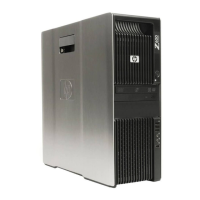Heading Option Description
Device Security Makes the following devices available or hidden to the workstation:
●
Serial Port
●
Front USB Ports
●
Rear USB Ports
●
Internal USB Ports
●
System Audio
●
IEEE 1394 Controller (Not available on some models.)
●
Ethernet Controller
●
Ethernet Controller (ASF) (Not available on some models.)
●
SAS Controller (Not available on some models)
●
Legacy Diskette
●
Embedded Security Device
●
SATA 0-n
For each device, Device Available is the default setting and allows the operating system to access
the device. Device Hidden makes the device unavailable; it is disabled by the BIOS and cannot be
enabled by the operating system.
NOTE: An entry for enabling DriveLock appears in the setup menu if the workstation has a
DriveLock-compatible hard disk drive.
Embedded
Security Device
This option becomes available if Embedded Device is set to Available.
Embedded Security Device (Hidden or Available) turns the Trusted Platform Mechanism (TPM) on
and off. Device Hidden is the default. If this option is made available, the following options become
available:
●
Power-On Authentication Support—Enables and disables an authentication feature that
requires you to enter a TPM user key password to start the workstation. This feature uses the
TPM to generate and store the authentication password.
●
Reset Authentication Credential—Resets the authentication functionality and clears
authentication credentials.
To enable the Embedded Security Device and to access any security features associated with the
device, you must enter a setup password.
Setting a device to Available enables the operating system to access the device. Hidden makes
the device unavailable. It is disabled by the BIOS and cannot be enabled by the operating system.
Network Service
Boot
Enables or disables the ability to boot to the network using the F12 key or the boot order.
System IDs Provides these options:
●
Asset Tag—A 16-byte string identifying the workstation.
●
Ownership Tag—An 80-byte string identifying ownership of the workstation. This tag appears
on the screen during POST.
●
Universal Unique Identifier (UUID)—Can only be updated if the current chassis serial number
is invalid. (These ID numbers are normally set in the factory and are used to uniquely identify
the workstation.)
●
Keyboard—Enables you to set the keyboard locale for System ID entry.
Table 4-1 Computer Setup (F10) Utility menu descriptions (continued)
ENWW The Computer Setup (F10) Utility 37

